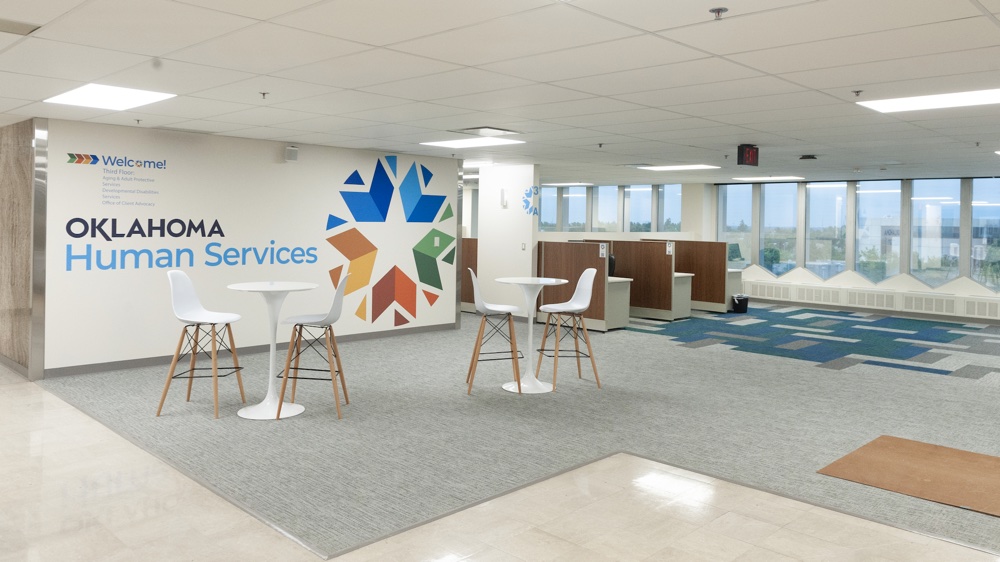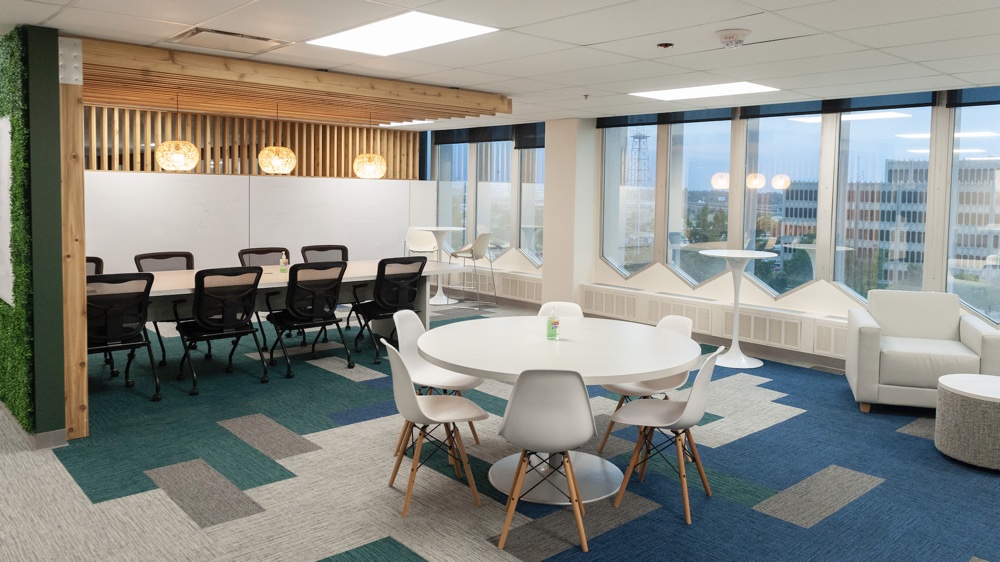Project Snapshot: Reimagining the Role of Real Estate in Benefits Delivery
Oklahoma Human Services (OKDHS) modernized their service delivery by reducing their real estate footprint, designing trauma-informed and user-friendly spaces, and expanding an embedded worker program to improve accessibility and client experience. Through their “Service First” strategy, OKDHS aims to create more equitable and compassionate interactions, reaching vulnerable populations while addressing high occupancy costs.

Problem Statement
When Oklahoma Human Services (OKDHS) set out to improve how they serve clients and support their workforce, they identified their physical spaces as an area in which modernization could improve accessibility and quality of service. OKDHS buildings tended to be large and securitized, with sizable waiting rooms and limited space for privacy; this set-up did not meet the needs of service users. At the same time, OKDHS was accruing high occupancy and maintenance costs due to its large real estate presence, which included many buildings that were not being used fully.
Project Description
Beginning in 2019, OKDHS took steps to reimagine how they can deliver the highest standard of equity, efficiency, and compassion in their day-to-day work with benefits applicants and beneficiaries. To that end, OKDHS vastly reduced their real estate footprint by closing down old buildings, designing new and more user friendly spaces for client interactions, and growing their embedded worker program to deliver service from within the communities which they serve. The “Service First’‘ strategy was developed through feedback from their staff, and aimed to meet clients where they are.
OKDHS’s real estate modernization project occurred in two phases. The first phase of the project involved closing down older, underutilized buildings that weren’t meeting the needs of the department. In an interview with the Digital Benefits Network team in early 2023, OKDHS leadership shared that they have closed 41 out of their 92 locations, with most closures happening in urban areas like Tulsa and Oklahoma City.
The second phase of the project included locating, designing, and adapting new spaces for better benefits delivery practices, as well as building-up a robust embedded worker program across the state. Through conversations with public-facing staff, OKDHS leadership decided to design three different types of spaces; Human Services Centers, child welfare centers, and administrative spaces. The Human Services Centers were created to handle in-person and virtual client interactions and resemble retail spaces. With the help of a team of in-house architects, OKDHS designed the spaces to be welcoming and to maximize accessibility, privacy, and comfort. For example, a staff member welcomes people soon after they walk in through the door, engaging them in a conversation about their needs and the services that they are hoping to access. Public-facing workers have been given additional training so that they can effectively address the diverse needs of those seeking services. Staff members are also trained on a custom Salesforce instance, “Be a Neighbor,” through which they can track an applicant’s interactions with Oklahoma Human Services and find information about community partners and organizations that could assist them, such as local food pantries. The Human Services Centers are also equipped with virtual interview rooms, in which applicants are able to connect with staff and case-workers from other agencies, enabling them to complete the benefit application processes while there, without having to come back or go to another office.
The trauma-informed child welfare spaces have been reserved for children’s services and have the capacity to handle emergency intakes, family visits, and welfare team consultations. The administrative spaces, designed with OKDHS’ staff hybrid or fully remote work schedules in mind, are a place for staff to access equipment and to facilitate employee training and culture building.
In addition to the new spaces, OKDHS has expanded their embedded-worker program, through which staff members are stationed within service delivery spaces throughout the state, such as schools, hospitals, shelters for unhoused individuals, and jails. On-site, staff members can provide specific services and resources for those requesting them at the location. As of spring 2023, there are around 400 part and full-time embedded workers.
Project Outcomes and Impact
OKDHS serves a high volume of clients in person; in 2023, between January 19 and April 18, the agency recorded 58,847 check-ins or interactions across their physical locations. OKDHS leadership believes that the real estate modernization and the “Service First” strategy will continue to improve the experience of those seeking services or resources. By increasing the number of embedded workers and the area where they are distributed, the agency hopes to reach those who may experience a heightened need for services, including people in jails and shelters for the unhoused. Concurrently, the embedded worker program aims to reduce the need for many benefit seekers to access Human Services Centers spaces in the first place, ensuring that agency staff have the capacity to address the needs of whoever may need to come into the space. Additionally, remote working options for caseworkers, state-wide workload sharing practices, and the capacity for remote eligibility determination in Human Services Centers is targeted to alleviate geographical disparities in the accessibility of services and wait times.
Replicable Takeaways
The real estate modernization strategy was shaped by feedback and reflections from staff across OKDHS; leadership required division-level input and consent in deciding which buildings would close and where new spaces were to be located. OKDHS’s work to streamline and improve how they serve clients in-person advocates for the value of intentionality in the design of spaces and deciding where workers are located.
